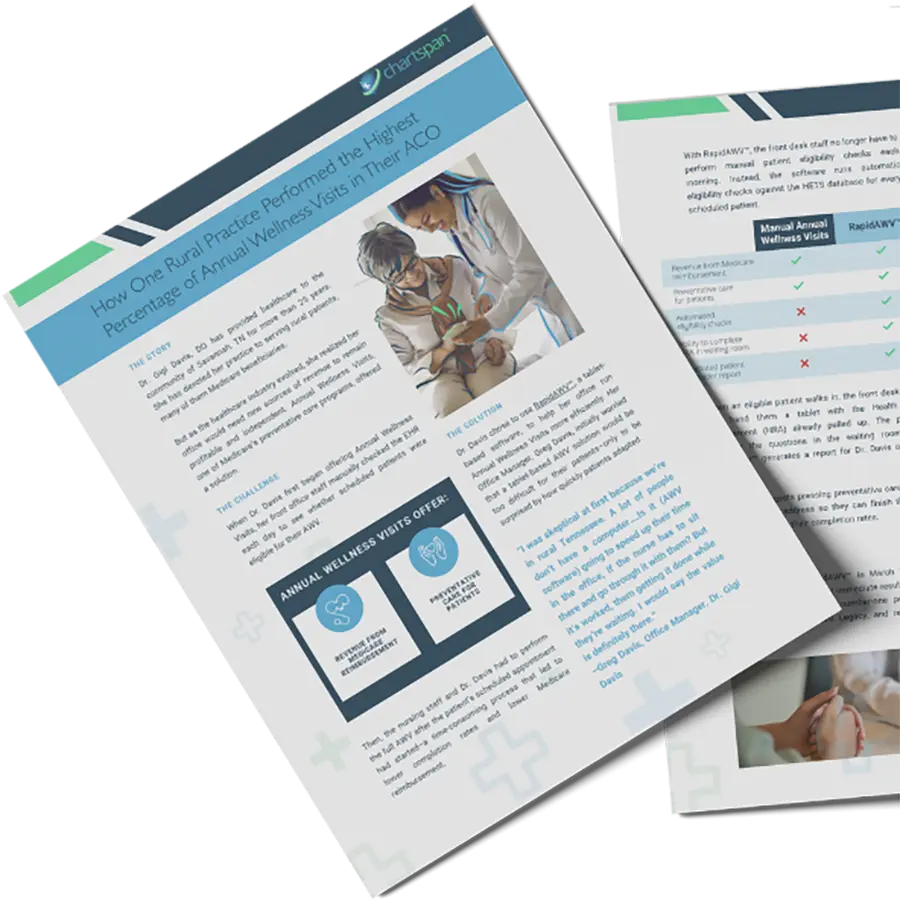
Talk with a ChartSpan Representative Today!
Our team is ready to help you improve patient care and outcomes.
Blog
Medicare Annual Wellness Visit vs. Annual Physical
Co-authored by Ashley Trice, AWV Product Specialist
Annual Wellness Visits (AWV) and annual physicals are incredibly important for patients, and they are often mistaken as the same service because they sound similar. However, these two types of visits significantly differ, so it's crucial to bill patients correctly. While a physical includes a full examination and a wellness evaluation, an Annual Wellness Visits focuses solely on a patient's answers to a health risk assessment.
It does not typically include any lab work or tests requiring physical contact. Continue reading to learn more about Annual Wellness Visits and how they can be optimized for a better patient and provider experience.
Understanding the Difference
An AWV is vastly different from an annual physical, but they are often mistaken as the same type of visit. The only way to use these terms correctly is to learn what distinguishes them from each other. In this blog, we will explore what sets an AWV apart from an annual physical, and why it’s important to know the difference.
What Does a Wellness Visit Cover?
The belief that AWV are the same as annual physical exams is a common misconception in the medical industry. This likely comes with most people being familiar with annual physical exams or checkups and assuming that an AWV is the same thing. However, they are quite different.
Medicare’s Annual Wellness Visits (AWV) are annual preventive visits for patients to create or update a personalized prevention plan. These preventative visits are designed to let the patient explain to their provider how they feel about their health status by filling out a health risk assessment. The provider can then use the collected information to identify risk factors, suggest appropriate preventive services, and create a personalized prevention plan for the patient.
These visits are comprised of three main components:
- Health Risk Assessment (HRA) - The first component of an AWV entails patients completing a self-administered questionnaire that addresses all facets of their health and well-being. For the HRA to be deemed compliant, patients must self-report information on the following topics:
- Demographics
- Self-Assessment of Health Status
- Behavioral Risks
- Medical History and Family Health History
- Psychosocial Risks
- Activities of Daily Living
- Instrumental Activities of Daily Living
The risk-assessment questionnaire may also include questions about advance care planning. Based on the patient’s answer to the HRA questions, the provider can identify risk factors, such as cognitive impairment, and create a personalized prevention plan to follow.
- Vitals - The second component is collecting and documenting vitals. These routine measurements include height, weight, and blood pressure which are essential to analyze when discussing risk factors related to cardiovascular disease, stroke and hypertension. Height and weight are used to calculate and report on body mass index (BMI).
- Consultation - The third component of an AWV consists of translating the HRA results into a five to ten-year care plan. Based on patient responses in the questionnaire, providers can identify risk factors and discuss a preventative plan of action geared toward a healthier future.
The Difference Between an Annual Wellness Exam Versus a Physical
Let’s take a look at the differences between AWVs and annual physicals in the table below. One of the most significant distinctions is that a physical exam is more extensive than a wellness visit. An AWV mainly consists of assessments and does not require a physical exam, but an annual physical does require an AWV.
Keeping the main distinction between these two exams in mind, it is easy to understand the other differences since there is no physical touch involved in an AWV but there is during a physical. For example, you would not perform blood work during an AWV since physical touch is involved.
| Annual Wellness Visit | Annual Physical | |
| Medical History | X | |
| Physical Exam | X | |
| Review of risk factors for illness | X | |
| Bloodwork, lab tests | X | |
| Personalized prevention plan | X | |
| Medication review | X | |
| Address new health problems | X | |
| Vaccinations | X | |
| Co-payment | X |
During an AWV, a health care provider reviews a patient's medical history and evaluates their risk factors for various illnesses. They will read a patient's responses to the health risk assessment and confirm their family and medical history. This information will help them determine risk factors and any prevention measures the patient may need to take. An AWV also lets the provider check a patient for any signs of frailty, dementia or memory loss.
The health care provider also reviews a patient's medications during an AWV and develops a personalized prevention plan that documents potential risk factors, available treatment options and individualized health advice. The prevention plan includes a screening schedule for preventive services to help the patient maintain their health and prevent potential illnesses.
An annual physical includes a wellness exam and a full physical exam including blood work, lab tests and vaccinations. During an annual physical, a health care provider addresses any new health complications a patient is experiencing. They also order any preventive tests such as cancer screenings the patient may be due for.
One of the other important differences between the two is that there is no coinsurance required for an AWV as Medicare covers this service fully, and reimburses providers for it. Medicare does not reimburse providers for annual physical exams.
What Is Not Discussed in an Annual Wellness Visit?
While a provider evaluates a patient's overall health to create a personalized prevention plan during an AWV, this type of visit does not include any discussion about treatment for current illness or chronic illnesses.
If a patient discusses current symptoms they are experiencing and receives care, a treatment plan or a prescription, they are charged a deductible or copay for that service. For example, if a patient receives care for abdominal pain or a prescription to treat an infection, this is considered a separate service not included in the wellness visit.
Treatment for chronic illness is also not included in an AWV. If a patient discusses a chronic illness with their health care provider during their visit or receives a prescription or treatment plan for their chronic illness, they are charged a deductible or copay. Chronic illnesses can include conditions such as diabetes, high blood pressure and high cholesterol.
What are the qualifications for Annual Wellness Visits?
So, who qualifies to receive an AWV? Let’s begin with identifying eligible patients. Medicare beneficiaries qualify to receive an Annual Wellness Visit from their provider, completely free of charge every year. However, the patient must be enrolled in Medicare Part B along with Medicare Part A (or Original Medicare) to reap the benefits of preventive health care services. Patients with Medicare Advantage plans are also eligible to receive preventive services such as AWVs, as long as they see an in-network provider. Ultimately, eligibility comes down to these two things:
- The patient has been enrolled in Medicare Part B services for over 12 months
- And, the patient has not received an AWV or the Welcome to Medicare preventive visit in the past 12 months
There are also requirements surrounding who is eligible to offer Medicare AWVs. This is great news if you are a primary care facility because you qualify to perform AWVs with your patients! But, you are not the only eligible provider able to offer this service. Specialists such as neurologists, cardiologists, rheumatologists, etc. qualify as well. Even urgent care clinics qualify to perform this service. However, since only one AWV can be done per patient, per year, a patient will not be eligible if they have already had their preventive visit with another provider.

Understanding the “Why”
So, why are Medicare Annual Wellness Visits valuable to health care providers and their patients? As the shift in health care from volume-based care to value-based care continues to grow in importance, preventive services like AWVs are crucial. AWVs are preventative services that identify gaps in care and improve the quality of care that providers deliver. In addition, they are proven to improve patient outcomes and reduce costs:
- There’s a 105% increase in colorectal cancer screenings for patients who get an AWV.
- There’s a 58% increase in pneumonia vaccinations for patients with an AWV.
- There is a 46% increase in breast cancer screenings for patients who get an AWV.
- A patient who receives an AWV improves medical outcomes resulting in $570 less annual Medicare expenses.
- 1,000 patients with an AWV can deliver more than a quarter million dollars in annual ACO shared savings*
These statistics show us the importance of preventive services like Medicare annual wellness visits. By conducting AWVs, health care providers can prevent future health problems and change the outlook of our health care industry as a whole.
Upgrade Your Annual Wellness Visits
Upgrade your practice or hospital's annual wellness visits with innovative software to gather important data and save time. RapidAWV™ software makes it easy to conduct wellness visits. This software lets providers connect with patients and collect data without interrupting practice workflows.
With customizable questions and a user-friendly format, patients can easily complete Health Risk Assessments so providers can create the best prevention plans possible. RapidAWV™ also completes accurate eligibility checks with a real-time eligibility verification feature, so you will always be aware of eligible patients.
Contact ChartSpan to Optimize Your Annual Wellness Visits
ChartSpan can help you optimize your billing process for Annual Wellness Visits to save you time while you provide excellent patient care. Optimize the AWV process with ChartSpan's RapidAWV™ software.
This innovative technology lets patients complete a health risk assessment in as little as 10-15 minutes so they can easily work with their provider to build a proactive health plan. RapidAWV™ software operates with special reporting logic that presents the most critical data first so providers can access important information quickly and easily.
Contact ChartSpan to learn more about RapidAWV™ software.

Subscribe for More Insights
Get valuable resources delivered straight to your inbox.
"*" indicates required fields





